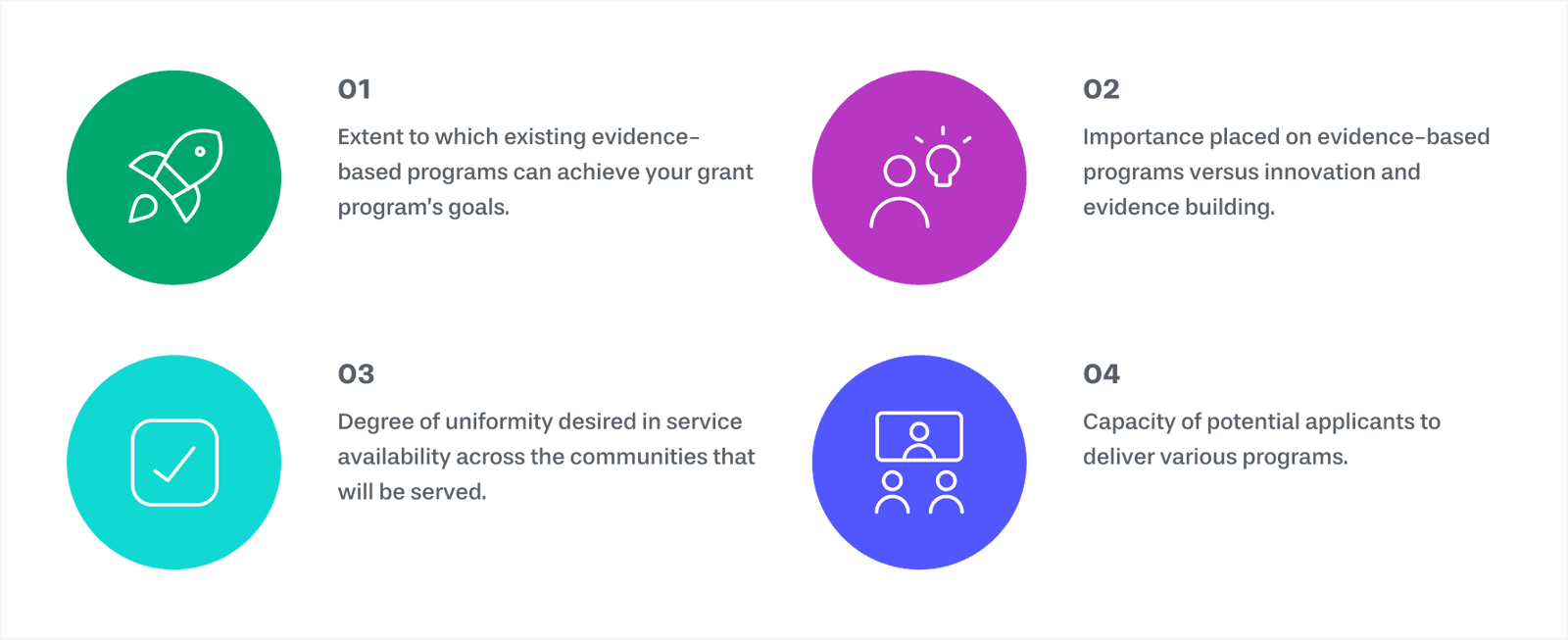Why It Matters
Prioritizing evidence helps ensure that a greater proportion of government dollars are invested in programs that are most likely to improve economic mobility outcomes.
Overview
There are two broad approaches to prioritizing evidence in federal grant programs:
Require that funding be used to support evidence-based programs (Evidence Requirement).
Allocate points to grant applications that meet the government’s evidence definitions (Evidence Preference/Bonus Points).
Federal agencies and/or Congress can require that all or some proportion of grant funds be invested in programs that are evidence-based. To carry out this approach, agencies can:
Require grantees to implement programs determined to be evidence-based by existing evidence reviews, such as Results for America’s Economic Mobility Catalog or a What Works Clearinghouse. Clearinghouses, which are publicly-available, centralized databases of evidence-based interventions, generally include information about federally-funded evaluations and other evaluations. These clearinghouses are a helpful support resource for federal grant program applicants, as they provide examples and insights into what qualifies.
Conduct a systematic evidence review to determine which programs are evidence-based.
Require grantees to document the evidence for a program that meets established criteria.
A growing number of federal competitive grant programs are awarding additional points to applications that include evidence in their proposals. Agencies can do this by having dedicated base points (i.e., 10 of the 100 points are awarded based on evidence) or bonus points (i.e., up to 15 additional points are awarded based on evidence).
When designing your evidence prioritization strategy, you’ll want to consider the:

Prioritize Evidence-Building
Prioritization should not be limited to current evidence-based strategies, as it is also crucial for government to evaluate new programs to continue to build new evidence of what works for whom under what circumstances. Evidence-building strategies that lack an evidence base but have informed rationale, meaning that there is a logical reasoning (such as a theory of change, logic model or narrative description), behind why a given approach is likely to improve important outcomes can be an important tool. Prioritizing evidence-building must include a credible evaluation, which will work to grow the evidence base over time. Results for America encourages governments to set aside at least 1% of their overall programmatic budgets to support ongoing evaluation, including for evidence-based programs.
OMB Encourages Evidence-Building
The 2024 Uniform Grants Guidance Revision from the White House Office of Management and Budget encourages state, local and tribal governments to invest federal funds in data infrastructure and evidence building. The guidance states clearly that federal grantees may use federal funds to support data and evaluation, including integrated data systems (§ 200.455(c)). It also specifies that integrated data systems and program evaluation costs may be considered direct or indirect costs, if they are related to the federal award (§ 200.413(b)).
With this new guidance, federal grantees can confidently make critical investments of federal funds in integrated data systems and analytic capacity. These investments, in turn, can help grantees understand, improve and report on program results effectively, provided there are no statutory barriers to these investments. The guidance offers clear examples of the breadth of activities included under data and evaluation costs. See RFA’s reference guide for implementing the 2024 Revisions to the Uniform Guidance here.
Economic Mobility Catalog
To aid practitioners as they seek to develop and implement evidence-based policy, Results for America created the Economic Mobility Catalog. An inventory of evidence-based strategies spanning seven issue areas and eight outcomes, the Catalog contains summaries of over 50 high-level strategies and nearly 200 specific practices and programs that have demonstrated positive results in rigorous evaluations. For every strategy, practice and program, the Catalog synthesizes the relevant research, identifies best practices for implementation and aggregates useful resources.